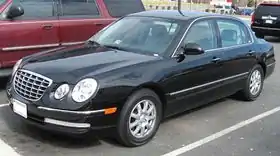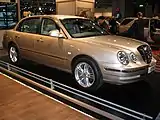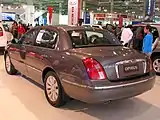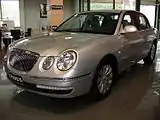Kia Opirus
The Kia Opirus is an executive car/full-size sedan, manufactured by Kia Motors and marketed over a single generation for model years 2003–2012 globally and 2004-2009 in North America. Having debuted internationally at the 2003 Geneva Motor Show,[2] the four-door, five-passenger, front-engine, front-drive sedan was launched to the North American market at the New York International Auto Show and in San Diego,[3] bearing the Amanti nameplate — and prioritizing luxury content and comfort over dynamic performance and agility.
| Kia Opirus | |
|---|---|
 | |
| Overview | |
| Manufacturer | Kia Motors |
| Also called | Kia Amanti |
| Production | 2003–2011 |
| Model years | 2003–2012 |
| Assembly |
|
| Body and chassis | |
| Class | Executive car/Full-size car (E) |
| Body style | 4-door sedan |
| Layout | Transverse front-engine, front-wheel drive |
| Related | Hyundai Grandeur XG/TG |
| Powertrain | |
| Engine | 2.7 L Delta V6 (gasoline) (2003-2006) 2.7 L Mu LPi V6 (LPG) (2010-2012) 2.7 L Mu V6 (gasoline) (2007-2012) 3.0 L Sigma V6 (gasoline) (2003-2006) 3.3 L Lambda V6 (gasoline) (2007-2012) 3.5 L Sigma V6 (gasoline) (2003-2006) 3.8 L Lambda V6 (gasoline) (2005-2012) |
| Transmission | 5-speed automatic (2003-2010) 6-speed automatic (2010-2012) |
| Dimensions | |
| Wheelbase | 2,800 mm (110.2 in) |
| Length | 4,980 mm (196.1 in) (2003-2006) 5,000 mm (196.9 in) (2006-2010) |
| Width | 1,850 mm (72.8 in) |
| Height | 1,485 mm (58.5 in) |
| Curb weight | 1,665–1,864 kg (3,671–4,109 lb) |
| Chronology | |
| Predecessor | Kia Enterprise (Made by Mazda) |
| Successor | Kia K7/Cadenza |
Intended to give Kia upward access to global premium markets, the Opirus represented a departure for the brand in both styling and market positioning. Developed over 22 months at a cost US$167 million (€143 million), 18% of the overall development cost went to R&D investment and 41% to development of production technologies.[4]
As Kia's first premium vehicle, the Opirus replaced the Mazda 929-derived Enterprise in the Korean Domestic Market.[4] The Opirus was also the first Kia vehicle sharing a platform with sister company Hyundai,[4] using a variation of the third generation Hyundai Grandeur/XG Y4 platform. For the Oprius, the platform was lengthened 1.9 inches, overall length increased 4.1 inches and height increased 2.6 inches.[3] As Kia's largest sedan, the Opirus was marketed in a single trim level, sharing components with the Grandeur/XG, and a range of engines including its 3.5 L V6 engine (North America). All models were manufactured in Kia's Hwaseong Plant plant near Incheon.[3]
A 2007 facelift, introduced at the 2006 Paris Auto Show, included upgraded specifications, a curb weight reduction of 250 pounds,[5] suspension and styling revisions, and a 3.8 L V6 engine (North America).
The name Opirus referred to the ancient city of Ophir, noted for its wealth[2][6] — and was selected via an online survey from the choices of Opirus, Regent and Conzern.[6] In 2004, the New York Times described the name Amanti as an untranslatable latinate construction, intended to connote luxury.[7]
Design and equipment
The Opirus' styling — described variously as conservative,[8] neo-classic,[4] restrained, unoriginal and derivative[8] — drew cues from disparate sources, notably the fourth generation Mercedes E-class (W212), Lincoln Town Car and Lancia Thesis.[2][9]
In the Korean Domestic Market, interior features included available heated and reclining rear seats[3] high-intensity-discharge headlights, navigation system, electro-luminescent gauges, ignition immobilizer, reverse parking sensors and electronically adjustable suspension settings.[10]
In North America, the sedan was marketed to value-sensitive 40-to-60-year-old professionals[4][3] with standard equipment at introduction including manually tilting leather-wrapped, four-spoke steering wheel[3] with faux woodgrain inserts and remote audio and cruise controls; faux wood grain dash, console and door accents (lighter prior to the 2007 facelift, darker thereafter); power locks and windows; CD player with six speakers; electronic driver- and passenger-adjustable climate control; front, curtain and side airbags;[3] dual zone automatic climate control; keyless entry;[10] herring bone cloth interior; glove-box only key; elongated LED turn-signals; rain-sensing windshield wipers; analog clock;, foot-operated parking brake (releasable by a dash-mounted pull-handle); power moonroof; 16" alloy wheels; full-size spare on an alloy wheel;,[11] and an eight-way powered driver's bucket seat and four-way passenger bucket seat[12] with door-mounted adjustment controls using a "mock-seat" ergonomic design.[10] The interior received heavy acoustic insulation,[13][8] and later models included heated rear seats, and electro-luminescent instrument lighting.[13] European models include two ISOFIX anchorage points.[4]
Options included leather interior, 270-watt Infinity stereo with subwoofer and six-disc changer,[12] dashboard LCD screen, trip computer with 4" LCD screen, heated seats, Adjustable pedals, auto-dimming rearview mirror, and pearl coat paint.[3] Safety equipment included eight airbags, and obstruction-sensing, anti-pinch power windows.[11]
The Opirus offered a passenger volume of 105.6 cubic feet[11] and a 15.5 cubic foot cargo volume[3] — the trunk equipped with a gas strut-assisted lid and luggage restraining net.[11]
In North America, J.D. Power and Associates recognized the Amanti as the "Most Appealing Premium Midsize Car" in its 2005 Automotive Performance, Execution and Layout Study.
Drivetrain
The Opirus was marketed globally with the 3.5L Sigma and the 3.8L Lambda engines. The North American Amanti featured the 3.5 liter engine producing 200 bhp at 5500 rpm and 220 lb.-ft. of torque at 3500 rpm.[10] Shifting was by a 5-speed automatic transmission, shifting either in fully automatic or manual sequential modes — the latter controlled via an "H"-shaped shift gate.[9] Steering was an electronically power assisted rack and pinion system[11] with an overall ratio of 15.24:1 and a turning radius of 5.7 meters.[4]
Suspension featured coil springs, anti-roll bars (26 mm front, 16 mm rear),[4] gas-pressurized shocks,[11] a front independent, double A-arm (wishbone) design[10] with unequal-length control arms and rear multi-link rear geometry.[9] Suspension included an ECS (electronically controlled suspension) system with automatic and sport mode, selectable via a switch adjacent to the transmission shift gate and the sport mode providing stiffer shock absorber settings.[4]
Brakes included 11.9/11.2-inch front/rear discs[14] with four channel, four sensors ABS (anti-lock brakes), BAS (emergency brake assist), EBD (electronic brake force distribution), TCS (traction control system), and ESP (electronic stability program).[4]
The Opirus is the first[4] Kia to integrate an Electronic Stability Program (ESP), developed with Continental Teves of Germany.[4]
Engines
| Model | Years | Transmission | Power@rpm | Torque@rpm | 0–100 km/h (0–62 mph) (Official) | Top Speed |
|---|---|---|---|---|---|---|
| Delta 2.7L | 2003–2004 | 5-speed automatic | 176 PS (129 kW; 174 hp) @ 6000 rpm | 24.2 kg⋅m (237 N⋅m; 175 lbf⋅ft) @ 4000 rpm | 206 km/h (128 mph) | |
| 2005–2006 | 182 PS (134 kW; 180 hp) @ 6000 rpm | 24.7 kg⋅m (242 N⋅m; 179 lbf⋅ft) @ 4000 rpm | ||||
| Mu 2.7L | 2007–2009 | 192 PS (141 kW; 189 hp) @ 6000 rpm | 25.5 kg⋅m (250 N⋅m; 184 lbf⋅ft) @ 4200 rpm | |||
| 2010–2012 | 6-speed automatic | 195 PS (143 kW; 192 hp) @ 6000 rpm | 25.6 kg⋅m (251 N⋅m; 185 lbf⋅ft) @ 4200 rpm | |||
| Mu 2.7L LPi | 2010–2012 | 165 PS (121 kW; 163 hp) @ 6000 rpm | 25 kg⋅m (245 N⋅m; 181 lbf⋅ft) @ 4000 rpm | |||
| Sigma 3.0L | 2003–2006 | 5-speed automatic | 187 PS (138 kW; 184 hp) @ 5500 rpm | 25.9 kg⋅m (254 N⋅m; 187 lbf⋅ft) @ 3500 rpm | 208 km/h (129 mph) | |
| Lambda 3.3L | 2007–2009 | 247 PS (182 kW; 244 hp) @ 6000 rpm | 31.5 kg⋅m (309 N⋅m; 228 lbf⋅ft) @ 3500 rpm | |||
| 2010–2012 | 6-speed automatic | 259 PS (190 kW; 255 hp) @ 6200 rpm | 32.2 kg⋅m (316 N⋅m; 233 lbf⋅ft) @ 4800 rpm | |||
| Sigma 3.5L | 2003–2006 | 5-speed automatic | 203 PS (149 kW; 200 hp) @ 5500 rpm | 30.4 kg⋅m (298 N⋅m; 220 lbf⋅ft) @ 3500 rpm | 9.2s | 220 km/h (137 mph) |
| Lambda 3.8L | 2005–2006 | 250 PS (184 kW; 247 hp) @ 6000 rpm | 35 kg⋅m (343 N⋅m; 253 lbf⋅ft) @ 3500 rpm | |||
| 2007–2010 | 267 PS (196 kW; 263 hp) @ 6000 rpm | 36 kg⋅m (353 N⋅m; 260 lbf⋅ft) @ 4500 rpm | 7.5s | 230 km/h (143 mph) | ||
| 2010–2012 | 6-speed automatic | 284 PS (209 kW; 280 hp) @ 6000 rpm | 36.4 kg⋅m (357 N⋅m; 263 lbf⋅ft) @ 4500 rpm |
 2003 Kia Opirus
2003 Kia Opirus 2007 Kia Amanti
2007 Kia Amanti 2008 Kia Opirus GL
2008 Kia Opirus GL 2009 Kia Opirus GL
2009 Kia Opirus GL
References
- "Avtotor". Avtotor.ru. Archived from the original on 2009-04-04. Retrieved 2010-10-30.
- "Kia Opirus". Autotalz.
- AARON ROBINSON (March 1, 2004). "2004 Kia Amanti Road Test". Car and Driver.
- April 11, 2007. "Kia Opirus (2005)". Netcarshow.com.
- "2008 Kia Amanti Review". Newcartestdrive.com. July 8, 2008.
- "New Kia luxury model will be called Opirus". Just-Auto.com.
- Jeff Sabatini (April 18, 2004). "BEHIND THE WHEEL/2004 Kia Amanti; Translating 'LeSabre' Into Korean". New York Times.
- Paul Williams (August 10, 2011). "2005 Kia Amanti Road Test". Driving.
- "2004 KIA AMANTI PREVIEW". Auto123.com.
The Kia also pulls styling cues from a wide variety of premium products, the Mercedes-Benz E-Class and Europe's Lancia Thesis being the most obvious. But all said it combines them into a unique design, focusing in on its distinctive grille.
- Shaun Bailey (November 6, 2012). "Kia Amanti". Road and Track.
- "2006 Kia Amanti (Opirus)". Topspeed.
- "Kia Amanti Episode 2334". Motorweek.
- Paul Williams (August 10, 2011). "Road test: 2005 Kia Amanti". Topspeed.
- "2004 Kia Amanti: Korea, Kia and its new little big car, the Amanti". Autoweek. April 11, 2007.
- https://www.automobile-catalog.com/model/kia/opirus.html